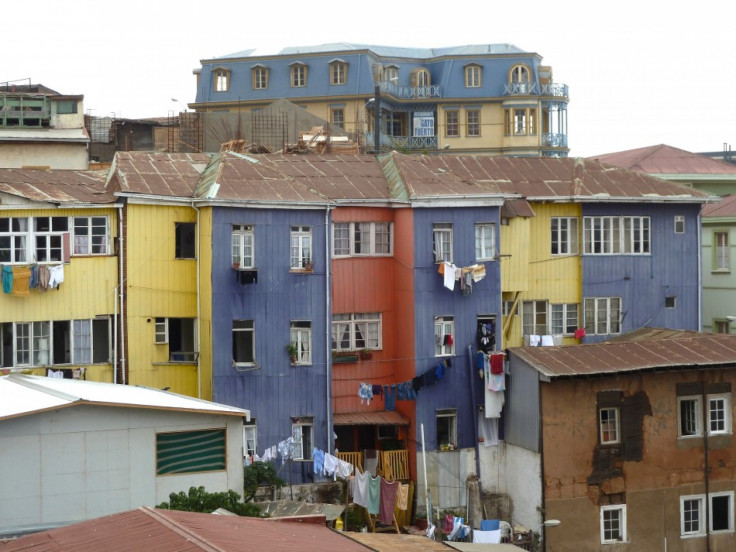10 Reasons To Visit Santiago, Chile

Santiago may lack the hype of Rio or Buenos Aires, but don't let that turn you away. Santiago is both cleaner and safer than its South American neighbors and its dramatic setting between the Andes and the Pacific makes it the perfect base for trekking, climbing, skiing, sunbathing, or wine tasting -- that's if you can escape the temptation to linger in town gorging on art and lazing in cafes. Chile's sprawling capital city is cultured, unpredictable, and very ambitious. Here's a look at 10 reasons it's not to be missed.
Cultural Centers
Though you'll find some of the best art by wandering the cobbled streets of Santiago's older barrios, there's no shortage of ultra-modern cultural centers to duck into and escape the mid-day heat. The best ones can be found at Estacion Mapocho, Matucana 100, and underneath the Palacio de La Moneda -- home to a compact exhibition on the art and music of Chile's beloved folk singer and artist Violeta Parra. You'll find more excellent art outside of these centers at GAM and the Museo National de Bellas Artes.
Parque Quinta Normal
Parque Quinta Normal houses over a half dozen museums within a meticulously manicured maze of greenery. Though only a few of them warrant a visit, the stately park is perfect for an afternoon stroll or, better yet, a leisurely paddle boat ride. If you decide to pop inside, try the Museo de la Memoria or the kid-friendly Museo de Historia National.
Barrio Brasil
Locals often wonder why tourists are so enamored by neighboring barrios Brasil and Yungay. Yet, with much of Santiago eaten up by modernity, this sizable slice of colonial color offers a glimpse of the city's past. Exploring crumbling colonial facades of Barrio Yungay, you'll find Santiago's most imaginative graffiti murals. Plaza Brazil's spindly araucaria offers little shade, but its artistic benches and innumerable cafes make it the perfect place to rest before heading south to the most charming area of all, the near-hidden Concha y Toro.
Cerro San Cristobal
Every city has its iconic park and for Santiago there's no doubt it's Cerro San Cristobal. Towering over the Chilean capital, this hill-hugging park is a recreational oasis with public pools, botanical gardens, and breathtaking views of both the city and the Andean peaks -- smog permitting. Santiguans come here to jog, bike, and hike. Tourists come to ride the rickety funicular up to the hilltop Virgin Mary statue and sip on mote con huesillo while taking in the panorama.
Concha y Toro
Concha y Toro is America's No. 1 imported wine from Chile and though it's sold under many names, chances are you've tasted the flavors of this famous wine. The majority of Chile's wineries require a car to visit -- not Concha y Toro. Reachable by metro and bus or a short taxi ride from the city center, this winery on Santiago's fringe offers an informative and entertaining introduction into Chilean winemaking. The grounds are beautiful, but a taste of Don Melchor will truly put you over the moon.
Lastarria
Santiago's hippest neighborhood really comes alive after work for the late afternoon tea time. Be it happy hour piscolas or an afternoon espresso, the arty bars and cafes of Lastarria ooze a calm coolness. As the sun sets, local hipsters peruse the trendy tiendas before crossing the Rio Mapocho for an evening in Barrio Bellavista.
Nightlife in Barrio Bellavista
Hardworking as they may be, Santiguans love to have a good time. Nowhere is that more apparent than in the bumping bars of Barrio Bellavista. Most action in Santiago takes place south of the comically underwhelming Rio Mapocho. However each night Santiguans cross the Pio Nono Bridge from the austere Plaza Italia to the laissez-faire side streets of Barrio Bellavista, tucked below Cerro San Cristobal and the watchful eye of Virgin Mary. Bars heat up after midnight and don't slow down until the break of dawn. If you want to keep up with the pisco-pounding locals, make sure to fill up on some late night street food like a completo or a churrasco.
Casa Pablo Naruda
Chile may be the only country in the world where a dead poet is worshiped with rock star devotion. That poet, of course, is none other than Pablo Neruda. Neruda's three eclectic houses, including Santiago's La Chascona, are some of the republic's hottest tickets -- in fact, visits to the homes in Santiago, Valparaiso, and Isla Negra are often sold out for days in the heat of summer. Entering the world of Neruda at these fantastical properties, it's not hard to see why Chileans are gaga for this larger-than-life man. If there's one thing every Chilean wants you to see, it's the houses of Pablo Neruda.
Plaza de Armas
The historic heart of Santiago, Plaza de Armas continues to pulse with excitement. For better or worse, it has all the makings of a tourist trap: cheap local food, semi-authentic art stands, a soap box atmosphere, and all the excitement needed to make a pickpocket's job easy. Plaza de Armas is certainly a must see, but one needn't linger too long.
Getaways
Santiago's idyllic position between the Andean highlands and the Pacific coast makes it a day tripper's dream. In the winter, world-class ski resorts like Portillo and Valle Nevado are a mere 1 1/2 hours away. A 1 1/2 hour drive in the other direction is Santiguan's summertime escape, the beach-rimmed Viña del Mar. Nearby is also the nation's cultural capital and Latin America's most unusual city, Valparaiso. There's no shortage of places to explore beyond Santiago's city limits.
© Copyright IBTimes 2024. All rights reserved.






















